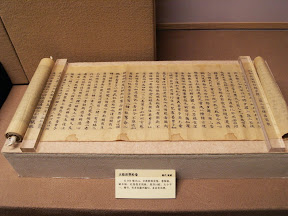The Nirvana Sutra ... Vol. 1
Blum, Mark [Übers.]:
The Nirvana Sutra : (Mahāparinirvāṇa-Sūtra) / translated by Mark
L. Blum. - Vol. 1. - Berkeley, Calif. : BDK America (distr.: Honolulu: Univ. of Hawai'i Press), 2013. - ca. 423 S.
Einheitssachtitel: Mahāparinirvāṇasūtra <engl.>
ISBN 978-1-886439-46-7
US$ 80,00
DDC: 294.385
Beschreibung
Volume 1 covers the first ten fascicles of the forty-fascicle Chinese translation made by Dharmakṣema (Taisho No. 374) in north China probably between 420-431. Subsequently there will be three more volumes to complete this translation, but only this first part of the Chinese text covers material for which there are Sanskrit fragments, a Tibetan translation from Sanskrit, and a second Chinese translation, all of which were consulted for this volume and are discussed in the notes. This book is part of the BDK English Tripiṭaka series and can be purchased at bdkamerica.org and soon from the University of Hawaii Press website.
Commonly known by the abbreviated title *Nirvana Sutra, *the Mahāyāna Mahāparinirvāṇa-sūtra is one of the most influential texts in East Asian Buddhism, having equal authority with the Lotus Sutra in the classification of scriptures crafted by Zhiyi of the Tiantai school as the final statement of Śākyamuni before his demise or, more appropriate for this text, disappearance from history. In East Asia this text is best known as the locus classicus for the doctrines of buddha-nature and vegetarianism, and served as the primary scriptural statement of tathāgatagarbha thought in which "buddha" is defined as a constant but ahistorical presence. As an early sutra from the middle period of the development of Mahāyāna in India, it also functions as a critical scholastic treatise on Buddhist thought and practice within the larger Buddhist community in India at the time of the sutra's composition probably in the fourth century. As such, it advocates notions such as the importance of nonemptiness (aśūnyatā) as a cure for attachment to emptiness, violence in defense of the buddha's dharma, and the presence of a "mahā-ātman" conceived as a buddha relic within the individual, all of which presumably reflect influence from and a sense of competition with Hinduism at that time. The Mahāyāna Mahāparinirvāṇa-sūtra is also richly endowed with expressions of narrative folklore, Āyurvedic medicine, phonology, analogies to understand the nature of liberation, and much more. [Mark Blum]
Übersetzer
MARK L. BLUM, Professor of Buddhist Studies, Department of East Asian Languages & Cultures, University of California, Berkeley. Profile page
Quellen: Bukkyō Dendō Kyōkai; Mitteilung von Mark Blum, Mailing-List H-Buddhism, 24. Dez. 2013; University of Hawai'i Press; Bookbutler; Library of Congress
Bildquelle: Deadkid dk (Own work) [Lizenz: CC-BY-SA-3.0], via Wikimedia Commons
Bibliographie: [1]
References
- (2013). The Nirvana Sutra: (Mahāparinirvāṇa-Sūtra). 1,
Ähnlich
- Kritzer: Garbhavakrantisutra
- Habata: Mahāparinirvāṇa-mahāsūtra - Critical Edition
- Kim: La carrière du Bodhisattva
- Santideva and Bodhicaryavatara
- Mining for Wisdom within Delusion
- Exploring the Structure of Emptiness
- Gilgit Lotus Sutra manuscripts from the National Archives of India
- Avatamsaka Buddhism in East Asia
- Luminous Bliss
- Groundless Paths

